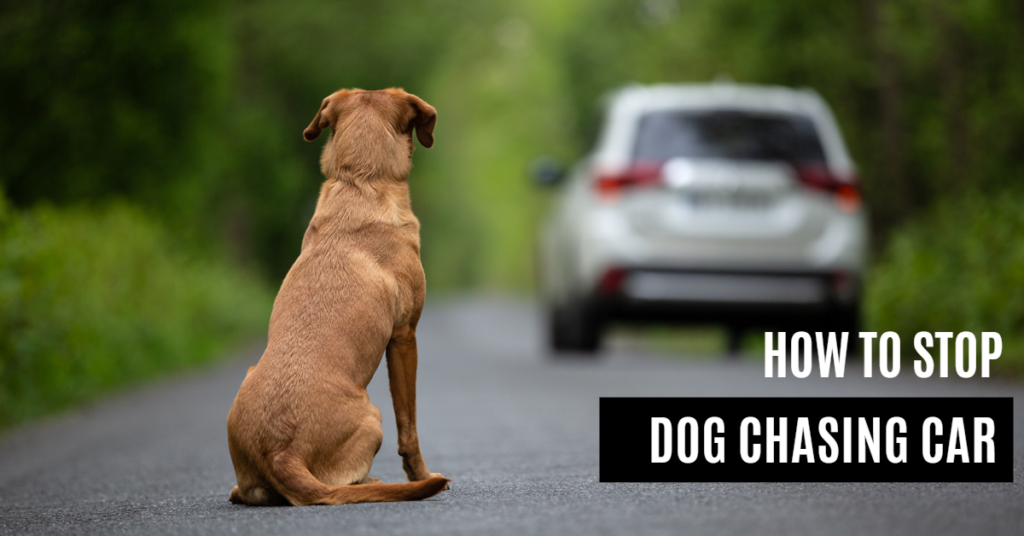Imagine a peaceful walk in the neighbourhood when suddenly your dog takes off after a passing car, risking their safety and causing panic.
Chasing cars can be dangerous and potentially life-threatening for dogs, not to mention the worry it causes for their owners.
To stop a dog from chasing cars, focus on training them with positive reinforcement techniques and providing ample mental and physical stimulation.
Discover the effective strategies to help you put an end to this risky behavior. From understanding the underlying reasons behind the chasing.to ways to stop them. So, let’s dive in and discover how to stop a dog from chasing cars once and for all.
How To Stop A Dog From Chasing Cars – Various Methods
To stop a dog from chasing cars, it’s crucial to address the behavior with a combination of training, management, and safety measures. Here are some steps you can take:
Training And Socialization
One of the most effective ways to stop a dog from chasing cars is through training and socialization.
- Teaching Basic Commands:
Teaching your dog basic commands like “stop” or “come” is like giving them a superpower. It’s like having a secret code that helps you communicate with your furry friend and keep them safe. Imagine being able to calmly call your dog back to you when they start eyeing that passing car!
- Socializing Your Dog:
Socialization is like introducing your dog to the world, one wagging tail at a time. It’s all about exposing them to different environments, people, and situations. Take them to the park, let them mingle with other dogs, and give them the chance to see cars passing by. This way, they’ll become more comfortable and less likely to chase after them.
- Building Trust And Bonding:
Training and socialization aren’t just about stopping your dog from chasing cars; they’re about building a strong bond of trust between you and your furry companion. When you invest time and effort into teaching them, they’ll begin to see you as their guiding light. The more they trust you, the more likely they’ll listen to your commands, even when faced with the excitement of a zooming car.
Exercise And Distractions
Another way to prevent chasing behavior in dogs is through exercise. A well-exercised dog will be less likely to have pent-up energy that leads them into chasing cars. Additionally, providing distractions like toys or puzzles can keep your pup occupied while outdoors.
- Get Those Paws Moving:
Taking your furry friend on regular walks or engaging in other physical activities like playing fetch can do wonders for their energy levels. It’s like hitting the gym for them, but with a lot more tail wagging and happy barks!
- Playtime With Purpose:
Dogs love toys, and they can be a great tool to redirect their attention from chasing cars. Whether it’s a squeaky toy, a puzzle treat dispenser, or a chew toy, find something that captures your pup’s interest and keeps them entertained.
- Mental Stimulation For The Win:
Just like us, dogs need mental exercise too. Try incorporating interactive games and puzzles into their routine to challenge their brains. It’s like giving them a little mental workout to tire them out and keep them from getting bored and seeking excitement in the form of car chasing.
- The Power Of Positive Distractions:
When you’re out and about with your pup, bring along some high-value treats or a favorite toy. If they start fixating on passing cars, redirect their attention by offering a tasty treat or engaging them in a game of tug-of-war. It’s all about creating positive distractions that help break their focus on those speedy vehicles.
- Mix It Up For Added Fun:
Variety is the spice of life, and the same goes for your dog’s exercise and distractions. Explore different walking routes, visit new parks, or try out new toys to keep things interesting. The more variety you offer, the more engaged and content your pup will be, reducing their desire to chase after cars.
Obedience Training And Positive Reinforcement
Positive reinforcement works wonders when it comes to training dogs not to chase cars. Rewarding good behaviors with treats, praise, or playtime encourages them to repeat the behavior more often. Obedience training also helps establish boundaries between what behaviors are acceptable versus those that aren’t.
- Treats As Motivation:
Dogs absolutely love treats, so using them as a reward during training can be highly effective. Imagine your furry friend’s tail wagging with excitement as they eagerly await their well-deserved treat. It’s like their own little victory celebration!
- Praise For A Job Well Done:
Dogs thrive on praise and positive attention from their owners. When they exhibit good behavior, give them a heartfelt “good boy” or “good girl” in your most enthusiastic tone. Watch their eyes light up with joy as they bask in the warmth of your appreciation.
- Playtime As A Reward:
Dogs have a natural instinct to play, so incorporating playtime into training sessions can be both fun and rewarding. Take a moment to engage in their favorite game, whether it’s a game of fetch, tug-of-war, or simply running around in the backyard. The sheer excitement in their wagging tails will make you smile too.
- Boundaries And Understanding:
Dogs are intelligent creatures, and they appreciate knowing what is expected of them. Obedience training helps establish clear boundaries, providing them with a sense of structure and guidance. It’s like teaching them the rules of the game, making it easier for them to make the right choices.
- Patience And Consistency:
Rome wasn’t built in a day, and the same goes for training your dog. It takes time, patience, and consistency to teach them new behaviors and break old habits. Don’t get discouraged if progress is slow at first. Remember, every small step in the right direction is a win. Stay consistent, keep practicing, and celebrate every milestone along the way.
Reasons Why Dogs Chase Cars
- Prey Drive: Dogs have a natural instinct to chase moving objects, including cars, due to their prey drive inherited from their wolf ancestors.
- Boredom and Lack of Exercise: Dogs that don’t receive enough physical activity and mental stimulation may engage in car chasing as a result of pent-up energy and boredom.
- Anxiety and Fear: Some dogs may feel anxious or fearful in response to loud noises associated with cars, leading them to exhibit aggressive behaviors towards the perceived threat.
By understanding these underlying reasons, pet owners can better address and prevent their dogs from chasing cars through proper training, exercise, and providing a stimulating environment.
More Tips To How To Discourage Chasing Behavior
Aside from the methods mentioned earlier, there are other ways to discourage your dog’s chasing behavior.
One of them is by providing mental stimulation. Boredom can often lead to destructive and impulsive behaviors such as chasing cars, so it’s important to keep your dog mentally engaged.
Interactive toys such as puzzle feeders or chew toys can help keep your dog occupied and stimulated throughout the day. Additionally, taking different routes during walks or switching up your usual routines can provide new sights and smells that will pique their interest.
Another way to discourage chasing behavior is by using deterrents. This could be something as simple as a loud noise or a sudden spray of water when they attempt to chase after a car. You can also try using an aversive scent, like citronella or vinegar, in areas where you’ve noticed excessive chasing behavior.
Consult with a professional trainer or animal behaviorist if you’re struggling with stopping your dog’s chasing habits. They may have additional tips and strategies tailored specifically for your pet’s individual needs.
Remember that discouraging unwanted behaviors takes time and consistency. With patience and proper training techniques, you’ll soon see progress in curbing your furry friend’s desire to chase cars on the road!
Conclusion
As we come to the end of this article, it’s important to remember that stopping a dog from chasing cars is not an easy task. It requires patience, consistency, and dedication from the owner.
While training and socialization are the first steps towards preventing car-chasing behavior, it’s also crucial to provide your dog with enough exercise and mental stimulation. Distractions like toys or games can help redirect their attention away from vehicles.
Remember, every dog is unique – what works for one might not work for another. Always consult with a professional trainer or veterinarian if you’re having trouble about how to stop a dog from chasing cars.
FAQs
What is the best way to stop a dog from chasing cars?
The best way to stop a dog from chasing cars is through a combination of training, supervision, and providing alternative outlets for their energy and prey drive.
Why does my dog try to chase cars?
Dogs may try to chase cars due to their natural prey drive or instinctual behavior, as well as boredom, lack of exercise, or anxiety/fear triggered by the movement and noise of vehicles.
How do you train a dog not to lunge at cars?
To train a dog not to lunge at cars, use positive reinforcement techniques and redirect their focus onto a desired behavior.
Will a shock collar stop a dog from chasing cars?
While a shock collar may provide temporary suppression of the behavior, it is not a guaranteed solution to stop a dog from chasing cars and may not address the underlying causes of the behavior.
What is the safest way to secure a dog in the car?
The safest way to secure a dog in the car is by using a crash-tested and properly fitted harness or a secured crate.



